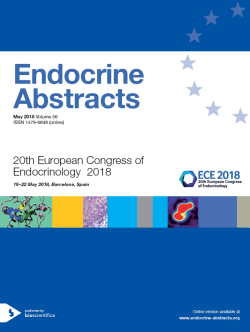
20th European Congress of Endocrinology
Barcelona,
Spain
19 May 2018 - 22 May 2018
Poster Presentations: Interdisciplinary Endocrinology
Cardiovascular Endocrinology and Lipid Metabolism
ea0056p624 | Cardiovascular Endocrinology and Lipid Metabolism | ECE2018
Impact of the metabolic syndrome on the renal function after partial nephrectomy for nonmetastatic localized renal cell carcinoma
Chaker Kays , Sellami Ahmed , Ouanes Yassine , Chehida Mohamed Ali Ben , Essid Mohamed Ali , Bibi Mokhtar , Abid Karem , Rhouma Sami Ben , Nouira Yassine
ea0056p625 | Cardiovascular Endocrinology and Lipid Metabolism | ECE2018
Is SFRP-4 an early potential biomarker related to diabetes and hypertension, in patients with androgenic alopecia?
Ipekci Suleyman , Sozen Mehmet , Abusoglu Sedat , Baldane Suleyman , Akyurek Fatma , Kirac Cem Onur , Kebapcilar Ayse Gul , Unlu Ali , Kebapcilar Levent
ea0056p626 | Cardiovascular Endocrinology and Lipid Metabolism | ECE2018
Multi-hormonal deficits in heart failure with preserved ejection Fraction: prevalence and impact on diastolic dysfunction
Bruno Carmine , Favuzzi Angela Maria Rita , Vergani Edoardo , Venuti Angela , Nicolazzi Maria Anna , Fuorlo Mariella , Landolfi Raffaele , Mancini Antonio
ea0056p627 | Cardiovascular Endocrinology and Lipid Metabolism | ECE2018
Cross-hormone treatment: review of cardiovascular risk factors and bone mineral density in 25 transsexual subjects followed in a tertiary hospital
Azkutia Ane , Herraiz Lorea , Jimenez Ines , Barrio Elvira , Ramos Elvira , Cuesta Martin , Diaz Angel
ea0056p628 | Cardiovascular Endocrinology and Lipid Metabolism | ECE2018
How the diagnose of the dilatation of ascending aorta in Turner syndrome can be verified?
Kriksciuniene Ruta , Zaikauskas Mindaugas , Lukosevicius Saulius , Zilaitiene Birute , Verkauskiene Rasa
ea0056p629 | Cardiovascular Endocrinology and Lipid Metabolism | ECE2018
Fibroblast growth factor-21 predicts adverse outcome in community-acquired pneumonia
Ebrahimi Fahim , Wolffenbuttel Carole , Blum Claudine A , Muller Beat , Schuetz Philipp , Christ-Crain Mirjam , Betz Matthias Johannes



